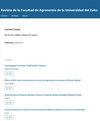Water productivity using furrow and drip irrigation in hybrid maize
IF 0.5
4区 农林科学
Q4 AGRONOMY
Revista De La Facultad De Agronomia De La Universidad Del Zulia
Pub Date : 2023-07-01
DOI:10.47280/revfacagron(luz).v40.n3.02
引用次数: 0
Abstract
Agriculture is the economic sector that consumes around 70 % of the total water extracted globally, considering itself a victim of its own inefficiency. The present work was oriented to look for irrigation alternatives that allow a greater productivity of water. The trial was carried out at the Faculty of Agricultural Sciences, Technical University of Machala, Ecuador. The amount of water applied to the corn crop through furrow and drip irrigation was evaluated. The treatments were: furrow irrigation, superficial drip irrigation and subsurface drip irrigation at 20 cm. The trial had a surface area of 450 m2, in a completely randomized block experimental design with three treatments and three repetitions. The control of the irrigation regime was carried out through tensiometers installed for each treatment. The volume of water applied and the dry grain yield in irrigation by furrows was 3,484 m3.ha-1 and 9,175 kg.ha-1, for surface drip irrigation of 1,452 m3.ha-1 and 10,200 kg.ha-1, and for subsurface drip irrigation it was 1,237 m3.ha-1 and 10,181.2 kg.ha-1. The water productivity for the furrow irrigation treatment was 2.63 kg.m-3, for surface drip irrigation it was 7.02 kg.m-3 and for subsurface drip irrigation at 20 cm it was 8.23 kg.m-3 being the highest productivity.沟灌和滴灌对杂交玉米水分生产力的影响
农业是消耗全球总用水量70%的经济部门,它认为自己是自身效率低下的受害者。目前的工作旨在寻找能够提高水的生产力的灌溉方法。这项试验是在厄瓜多尔马查拉技术大学农业科学学院进行的。对玉米作物采用沟灌和滴灌方式的施水量进行了评价。处理分别为沟灌、表面滴灌和20cm地下滴灌。试验面积为450 m2,采用完全随机区组试验设计,三次处理,三次重复。灌溉制度的控制是通过为每次处理安装的张力计进行的。沟灌的施水量和干粒产量为3484 m3。Ha-1和9175公斤。Ha-1,地表滴灌1452 m3。Ha-1和10200公斤。Ha-1,地下滴灌1237 m3。Ha-1和10,181.2 kg。沟灌处理的水分生产力为2.63 kg。M-3,地表滴灌为7.02 kg。M-3,地下滴灌20 cm为8.23 kg。M-3是最高的生产率。
本文章由计算机程序翻译,如有差异,请以英文原文为准。
求助全文
约1分钟内获得全文
求助全文
来源期刊
CiteScore
0.50
自引率
0.00%
发文量
45
审稿时长
>12 weeks
期刊介绍:
La Revista de la Facultad de Agronomía de la Universidad del Zulia publica artículos científicos, notas técnicas, comunicaciones rápidas y artículos invitados originales e inéditos, es decir, que no hayan sido publicados ni enviados simultáneamente a otra revista para su publicación, de autores interesados en el campo agrícola vegetal y agrícola animal. De presentarse el caso que el autor o autores hubiesen enviado o publicado su manuscrito simultáneamente en otra revista, podrán ser sancionados con la no publicación en esta revista por tiempo indefinido.
Se admiten manuscritos escritos en idioma Español, Portugués o Inglés, con un resumen en Español o Portugués y otro en Inglés (Abstract).

 求助内容:
求助内容: 应助结果提醒方式:
应助结果提醒方式:


